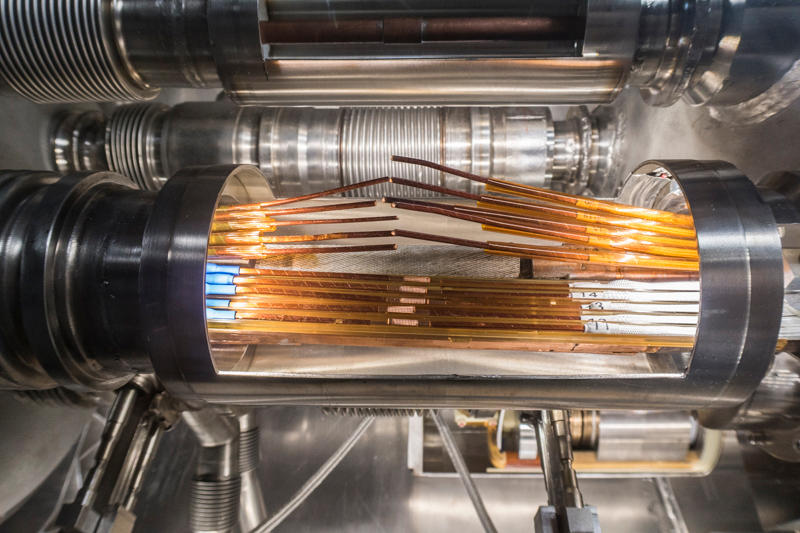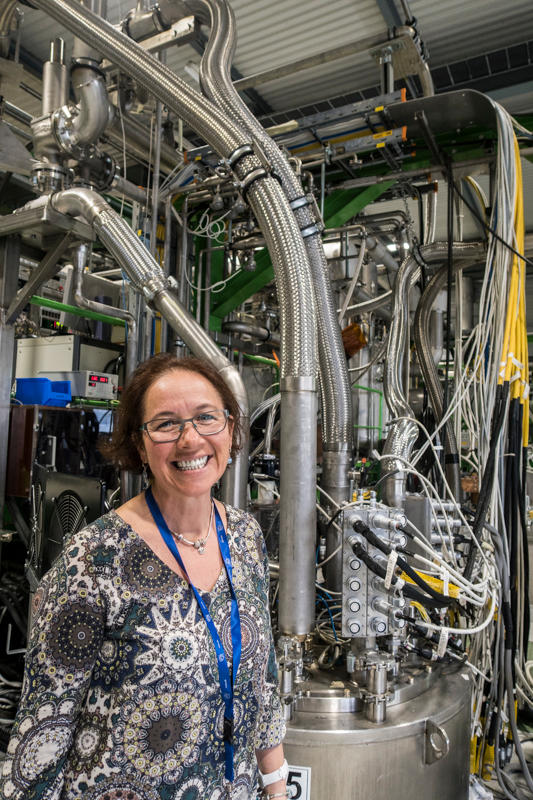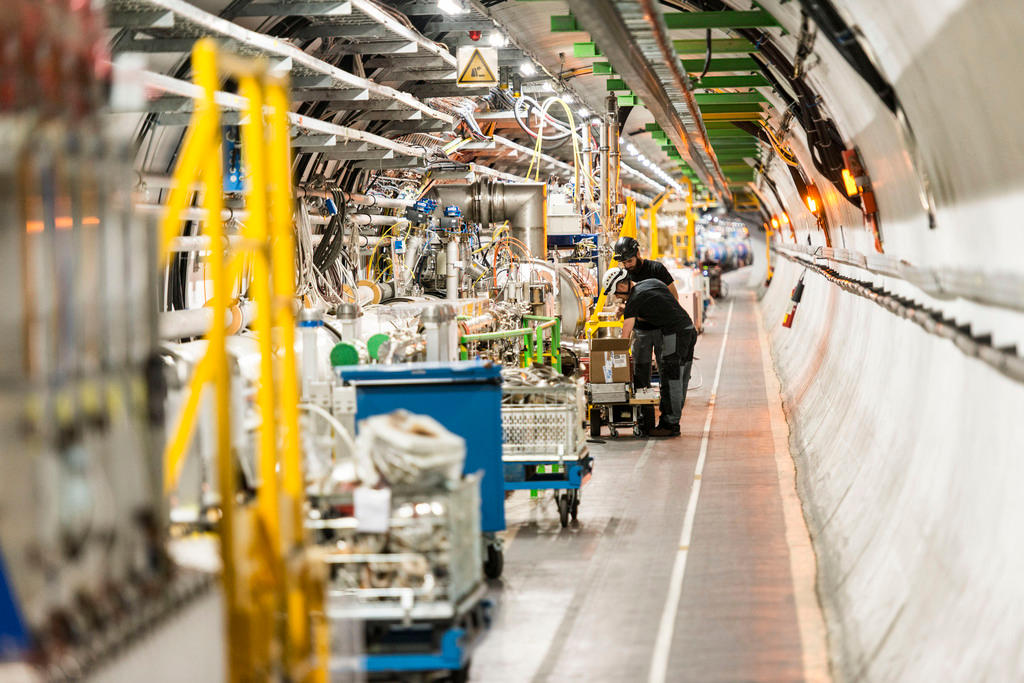Meet the engineers who make machines for understanding the universe

She may not be one of CERN’s vaunted physicists, who theorise about what happened nanoseconds after the Big Bang; but without engineers like Marta Bajko, who work on the giant magnets of the Large Hadron Collider, these physicists wouldn’t be able to test their theories.
At pop concerts there are the rock stars, who make the music, and there are the roadies, who make sure the music happens; tuning the instruments, and plugging in and powering up the amplifiers and speakers.
The rock stars at Geneva-based CERNExternal link, the European Organization for Nuclear Research, are the particle physicists. They get most of the attention when the centre discovers a new subatomic particle that helps us understand what the universe was probably like at its birth, and what it’s composed of today.
But without the engineers who design, construct, and test the complex machines and instruments that send those particles colliding into each other (on purpose) at nearly the speed of light, the mathematics would remain “just” theoretical equations.

Giant magnets
Continuing with the rock and roll analogy, Marta Bajko would be a roadie. But during a recent visit with her at CERN, she wore neither overalls nor lab coat, but rather a psychedelic print dress, purplish stockings, and a rainbow thread bracelet made by her seven-year-old daughter.
As a section leader at CERN’s superconducting magnet testing facility, SM-18, Bajko and her team of about 30 engineers and technicians test the giant magnets that operate at near-absolute zero (-273.15 degrees Celsius/-459.67 Fahrenheit) to achieve superconductivityExternal link (no electrical resistance). Some of these magnets have been designed to bend protons around CERN’s 27-kilometre (17-mile) circular Large Hadron Collider (LHC).
The LHC has 1,232 large dipole magnets that direct billions of protons each second around the collider before they smash into each other, leaving traces of even smaller subatomic particles – like the famous Higgs bosonExternal link, which explains why the universe has mass.
“Our first role is diagnostic,” says Bajko. “We receive a magnet and test it, trying to understand what’s working well, and what’s not. After our colleagues make any fixes necessary, then we test the final design.” Only after all tests are successful is the magnet approved for installation.
When a new magnet design is being tested, the entire process – from initial testing to refining, re-testing, re-refining, and final OK after installation – can take years. For example, Bajko’s team began work on the design of new magnets for the High Luminosity LHC upgradeExternal link in 2008. But the first prototype will begin testing only this year, with installation of the final magnets expected in 2025.
The engineer was born in Gheorgheni, Romania and educated there and in Budapest, Hungary. Like virtually everyone at CERN, she is multilingual (Hungarian, Romanian, Spanish, French, English, Italian). Her first job out of university was in Madrid at CEDEX.External link That’s where she found the two loves of her life: cryogenic engineering and her husband, Juan Carlos Perez, who is also a magnet engineer at CERN.
“I’m still amazed that the LHC – all these people and parts, nothing more important than the other – that they all work together.”
Real-world applications
A crucial component of CERN’s large superconducting magnets, which measure 15 metres in length and weigh 27 metric tonnes (nearly 60,000 pounds), are the cables wound with wires made of niobium-titanium alloy (NbTi) or niobium-tin (Nb3Sn). These alloys are exceptionally efficient electrical conduits at the extremely cold temperatures that enable superconductivity.
The threads of wire and flat cables can also be beautiful, notes Bajko, who says she’d one day like to make jewellery from this wire. In a vase on her desk she keeps a bouncy bouquet of the NbTi wires, cables and spiral ribbons of metal along with green optic fibres.
What does the engineer find most rewarding about her work? At the risk of disappointing pure science nerds, it’s not the discovery of esoteric subatomic particles that make up the universe. “That’s so far away for me,” she says. Instead, she cites the “real-world applications of cryogenics, superconductivity and magnets”. For example, the development of medical technologies like magnetic resonance imaging (MRI) machines owes a great deal to work done at CERN.
Playing and working together
As a section leader, Bajko spends part of her time in the office, in meetings and going over schematics and equations, but she loves being on what she calls her “playground”: the testing area of SM-18, which is about 2,500 square metres of large, brightly painted metal diagnostic machines and instruments. For some tests, the long magnets are laid on a “cryogenic bench” where they’re powered up to see if the many hundreds of parts play well together. Each magnet is also put into a device the engineer calls the “biggest thermos in the world” for further cryogenic testing.
A battery of tests on a single magnet can last more than two months. As testing progresses at gradually colder temperatures, the magnet “goes through training”, she explains. It “learns” and has a “memory”. With subtle tweaking, successive tests get closer to the magnet’s designed performance at near absolute-zero temperatures.
One of the most formidable challenges for the superconducting magnet engineers is fabricating magnet components at room temperature that must operate at nearly -300 C. Imagine building a car engine in a hot factory, but that engine has to work at temperatures colder than outer space.
“I’m still amazed that the LHC – all these people and parts, nothing more important than the other – that they all work together,” says Bajko.
So how well do the rock star physicists and roadie engineers work together? The engineer smiles. “The physicists are a little bit, dreamers,” she says. In her experience, often, the physicists don’t consider the difficulties of building a complex machine that has perhaps never existed before, but that they absolutely need to prove (or disprove) their theories. Nor, at times, do they consider the cost of designing and building such a machine. These concerns fall to the engineers, who explain to the physicists (and budget-watchers) what she calls “the feasibility of fabrication”.
Perhaps this is the great challenge and reward of exploring subatomic physics as a cryogenic magnet engineer – or any kind of engineer. “My work is not only on paper or on a screen, but in this installation that I can see, I can touch. And it is working.”

In compliance with the JTI standards
More: SWI swissinfo.ch certified by the Journalism Trust Initiative











You can find an overview of ongoing debates with our journalists here . Please join us!
If you want to start a conversation about a topic raised in this article or want to report factual errors, email us at english@swissinfo.ch.